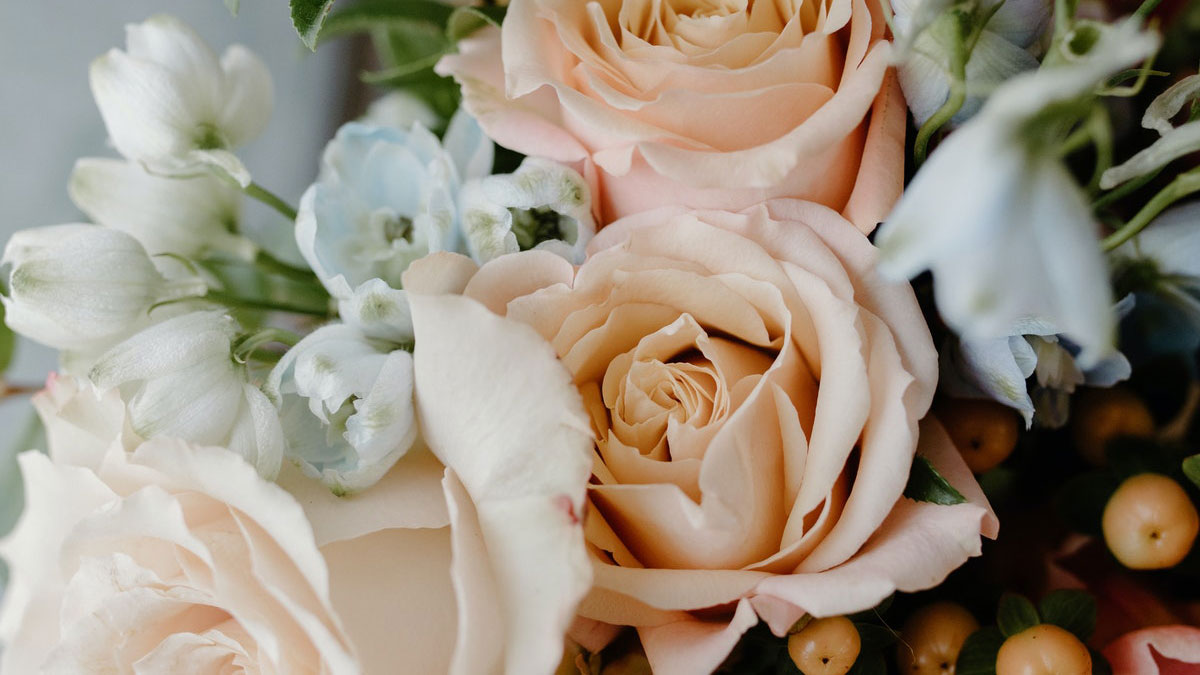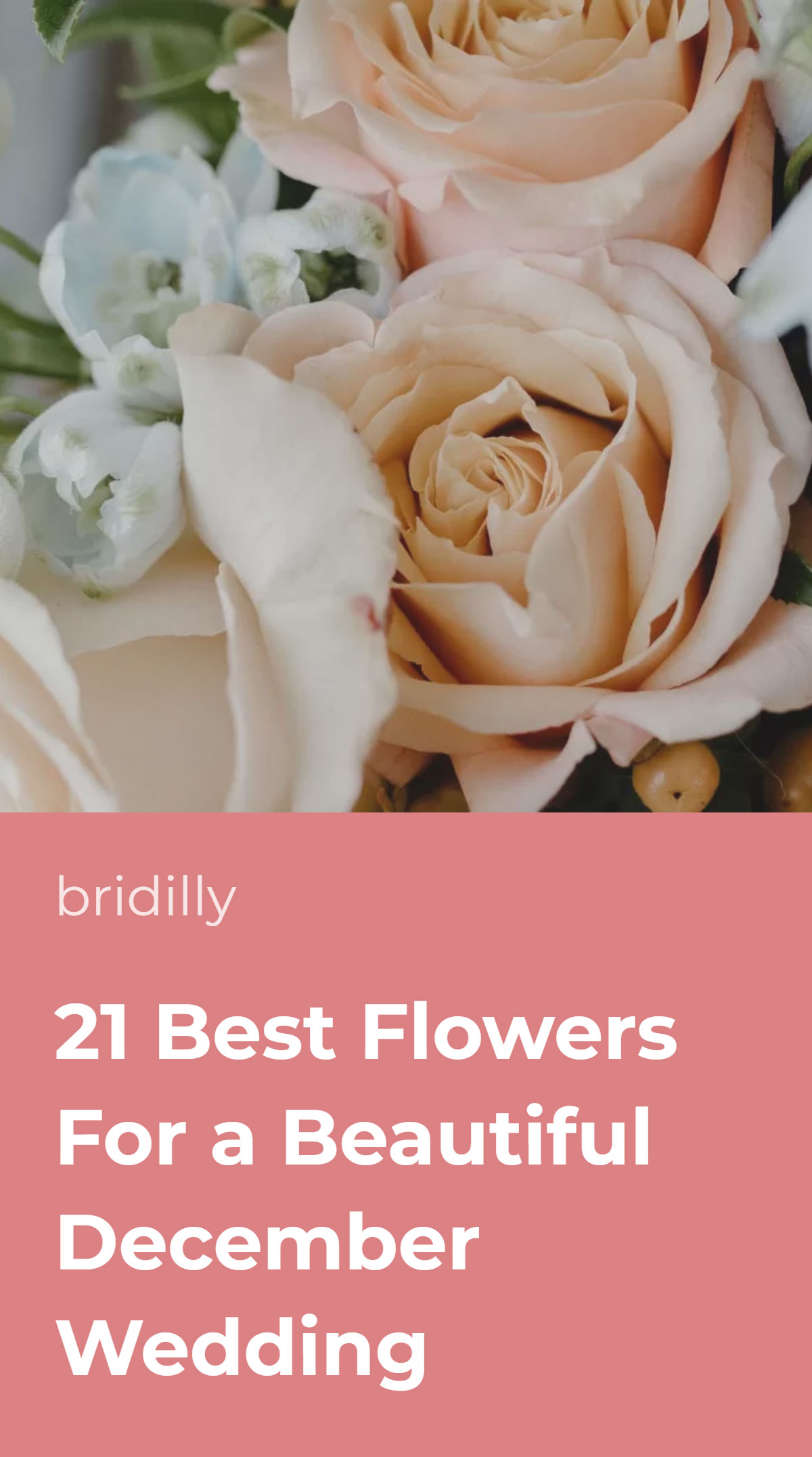Many brides think that the selection of December wedding flowers is limited, but it couldn’t be farther from the truth.
In reality, some of the most beautiful florals bloom in winter, and many garden flower varieties are available year-round.
While you can find summer flowers in December if you’re dedicated enough, only seasonal blooms can convey the unique winter appeal.
Furthermore, seasonal flowers are more cost-effective, have a longer vase life, and overall look fresher.
There’s a winter flower for any wedding style and preference, from exotic orchids and proteas to delicate waxflowers and sweet peas.
Table of Contents [show]
1. Freesia
Freesias are delicate wedding flowers available year-round. While freesias come in orange, yellow, pink, and other colors, white is deservedly the most popular shade for winter weddings.
Freesias work well in bouquets, centerpieces, hairpieces, boutonnieres, and venue décor. It’s a versatile flower that looks beautiful on its own but pairs well with just about any other seasonal bloom, especially tulips, amaryllis, and sweet peas.
2. Orchid
Perhaps, orchids are the most popular exotic wedding flower due to their wide availability and variety selection. The Phalaenopsis kind is the most common in wedding floral arrangements, but there are many more beautiful orchid species to consider.
Orchids look incredibly gorgeous in modern asymmetrical and cascading bouquets paired with other exotic blooms like calla lilies. However, they are equally suitable for minimalist arrangements and make perfect boutonnieres and hairpieces.
3. Rose
Roses are undoubtedly some of the most common and versatile wedding flowers. They come in various shapes, colors, and sizes, suitable for any wedding style.
Roses pair well with exotic and garden flowers and work in bouquets, venue décor, and boutonnieres. In other words, you can’t go wrong with roses – if you aren’t sure which flowers to choose for your wedding, go for gorgeous rose arrangements.
4. Amaryllis
Amaryllis are exotic bell-shaped winter blooms resembling lilies. They come in various pink, red, and orange shades, as well as pure white and two-toned.
Amaryllis size and shape make them suitable for just about any application, from hairpieces to venue décor. A white amaryllis bridal bouquet looks impeccably elegant.
If you prefer more diverse and colorful floral arrangements, combine unusual bi-colored amaryllis with calla lilies, orchids, and freesias.
5. Anemone
You can easily spot anemones by rounded petals and large black centers. These unusual flowers come in red, pink, purple, and blue shades, but the white anemone variety is best for a winter wedding.
Anemones look gorgeous with any other garden flower variety – peonies, roses, ranunculus, gardenias, and carnations, to name a few. A dark purple and burgundy anemone bouquet is excellent for a dramatic bridal look.
6. Hypericum Berries
The best way to make your bridal floral arrangements more attractive is by incorporating seasonal berries, fruits, and greens. Hypericum berries are a December wedding staple – they work equally well in boutonnieres, venue decor, and bouquets.
Hypericum berries come in burgundy, coral, green, orange, pink, and white colors and pair well with nearly any flower. For instance, combine bright red berries with snow-white peonies or light coral berries with peach roses and white anemones.
7. Sweet Peas
Sweet peas can bloom in spring or winter, depending on when they are planted. Sweet peas come in a variety of pastel and bright colors, including pink, blue, and purple.
These delicate flowers are impeccably dainty and romantic, especially in small minimalist bridal bouquets or boutonnieres. However, they also pair well with other textured flowers such as carnations, parrot tulips, or roses, serving as filler flowers.
8. Camellia
Camellias are beyond gorgeous blooms resembling roses, mainly available in white, cream, pink, red, purple, yellow, and combinations of these colors. But unlike roses, camellias grow on trees with large emerald-green leaves.
Camellias look stunning with peonies, roses, ranunculus, and other textured blooms or in minimalist camellia-only bouquets. Camellia leaves can make even the simplest floral arrangement unusual and attractive.
These elegant flowers work equally well as venue décor, bridal bouquets, hairpieces, and boutonnieres.
9. Carnation
Carnations are underused in floral wedding arrangements. Meanwhile, they are an excellent choice for any bouquet due to their low price and long lifetime.
Carnations have beautiful fringed texture and endless color selection, from white and blush to decorative two-colored varieties – one of the most unusual color combos is brown and blue.
10. Ranunculus
Ranunculus is an excellent alternative to roses or peonies. These flowers have a similar look and bloom throughout the entire winter. They are available in white, yellow, purple, cream, pink, orange, and red shades.
Ranunculus makes beautiful boutonnieres and centerpieces. In floral arrangements, it looks the best with other winter garden flowers, including carnations, gardenias, camellias, and anemones.
11. Poinsettia
If anyone asked you which flower you associate with December, you’d likely reply with poinsettia. While this bloom is strongly linked with Christmas, it works equally well for winter weddings, either as venue décor or part of a bridal bouquet.
Not many know, but poinsettias aren’t always red. They come in cream, pink, yellowish, and orange colors, sometimes two-toned or spotted.
Pair poinsettia with pines cones, evergreens, and hypericum berries for an ultimate festive atmosphere.
12. Hellebore
Hellebore is also known as winter rose or snow rose, although it resembles a rose much less than camellia or ranunculus.
Hellebores come in virtually any color, from white and green to dark purple. Typically, they have medium-sized blooms with five petals and a large yellow center.
Hellebores pair beautifully with anemones, ranunculus, amaranths, poppies, waxflowers, and berries. They work best in oversized bouquets and centerpieces.
Note that hellebores are fragile flowers with short vase life, so ensure they have enough water if used as venue décor.
13. Gardenia
Gardenias can be easily confused with camellias – they have a similar shape and grow on trees with large dark green leaves.
Gardenia has waxy petals and comes in pink, red, yellow, and purple shades, but no color can beat white in terms of popularity.
Gardenias look stunning in bouquets, wreaths, centerpieces, hairpieces, boutonnieres – you name it. It’s a versatile winter wedding flower that pairs well with any other garden bloom.
14. Calla Lily
Calla lilies are all-time winter wedding favorites. These trumpet-shaped exotic flowers are available in a range of colors, including pure white, dark purple, yellow, and blush.
Calla lily bridal bouquet is a chic choice for a minimalist bride. You may use a single color or mix different shades – for instance, white and purple or blush and peach.
Calla lilies also make excellent table décor, thanks to long stems. A single calla lily in a tall vase looks impeccably stylish.
15. Parrot Tulips
Most tulip varieties bloom in spring, but parrot tulips are in season in December. These unusual tulips have fringed petals and are typically two-toned, ranging from pastel blush and pale yellow to dramatic burgundy and plum.
Parrot tulips are interesting enough for mono-bouquets but go well with anemones, hellebores, peonies, freesias, and many other winter garden flowers.
16. Narcissus Paperwhite
Like tulips, most narcissus varieties are in season in spring. Paperwhites are an exception – they bloom from late fall to late winter. Narcissus paperwhite blooms have the same shape as yellow daffodils but are smaller.
Paperwhites are an excellent choice for mono arrangements, centerpieces, and boutonnieres. The best combinations with paperwhites are freesias, amaryllis, and tulips.
17. Buttercup
Buttercups are tiny, cheerful-yellow wildflowers that work best as bouquet fillers. However, there are also red, pink, and orange garden varieties.
Yellow may not be the most popular winter wedding color, but adding buttercups to your bridal bouquet is a great way to make it more colorful and optimistic.
18. Waxflower
Waxflowers are another winter wildflower variety with small, clustered blooms and short stems. These delicate white, pink, or purple flowers are a great addition to virtually any bouquet, centerpiece, or boutonniere.
Florists don’t usually use waxflowers in mono arrangements due to their tiny size. However, a small waxflower and hypericum berry bridal bouquet is a beautiful choice for a modest bohemian or rustic bride.
19. Leucadendron
Leucadendron is an exotic long-stemmed winter flower that comes in red, yellow, green, and white colors.
Leucadendron varieties can look entirely different – for instance, the “Ebony” variety has deep red pinecone-like blooms and purple foliage, while “Safari Goldstrike” leucadendron has lush green leaves and white flowers with a yellow center.
This unusual winter wedding flower is a great choice for creative brides who wish to stand out and consider roses and tulips too boring for such a big day.
20. King Protea
King protea is another unusual wedding flower with large outer bracts often confused with petals and cone-shaped florets.
Proteas are easy to distinguish from any other flowers due to such unique shape. They come in pink, white, cream, burgundy, and red colors.
King protea demands an equally unusual pair; otherwise, it will steal all the attention. Florists typically use proteas with leucadendrons, pampas grass, and greenery.
21. Evergreens
No plants suit a winter wedding better than evergreens. Spruce and fir branches make excellent venue décor and look beautiful in seasonal bouquets.
You may use evergreens in centerpieces, ceremony arch, aisle décor – the variations are endless. Combine them with pinecones and hypericum berries for a winter wonderland atmosphere.














No Comments Add one
Leave a Comment